Viewing search results for "University of North Carolina at Charlotte"
View All Posts
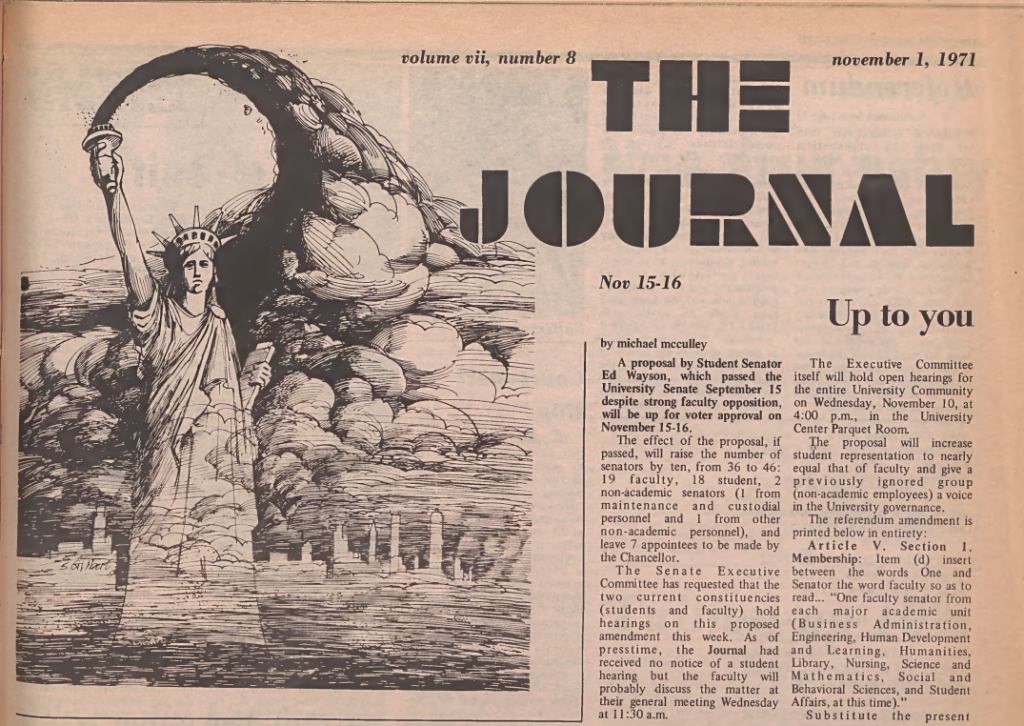
We are excited to announce the availability of 76 new issues of The Carolina Journal, the student newspaper from our partner University of North Carolina at Charlotte. The issues in this batch span September 1969 – July 1972 and offer an insightful glimpse at a tumultuous time in U.S. history.
Like many student newspapers, the issues cover topics like sports, school events, administrative updates. However, there are occasionally artistic, yet simple full-page features that replace the traditional first page of the paper during momentous events that particularly impact students. These pages set the tone for the rest of paper in a striking way.
Volume 5, Issue 27 and Volume 6, Issue 24 each pay homage to the four unarmed college students killed on May 4, 1971 by the Ohio National Guard at Kent State University during a mass protest against the bombing of Cambodia — an event now referred to as the Kent State massacre:
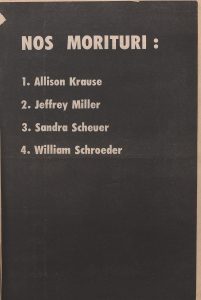
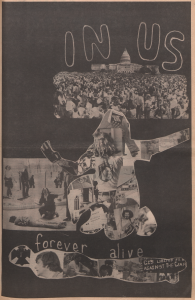
The English translation of the Latin “Nos Morituri” is “We are about to die”
Other full-page features make political or social commentary. The 1970 Halloween issue (Volume 6, Issue 6) features a perhaps unflattering depiction of President Ronald Reagan and Vice President Spiro Agnew in costume with a “bag of tricks” [on the left]; the February 1972 paper (Volume 7, Issue 15) celebrates Senator Edward Kennedy’s pro-Civil Rights statement during his January address to the Washington Press Club [on the right]:
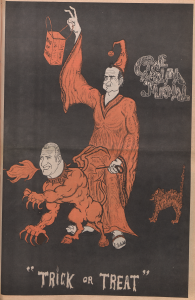
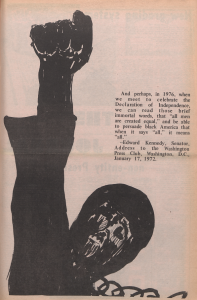
Editorial pieces and cartoons likewise make sociopolitical commentary in North Carolina and beyond:
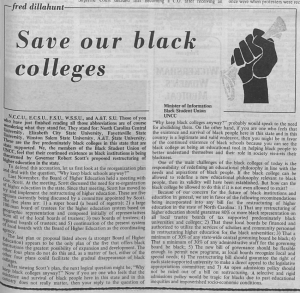
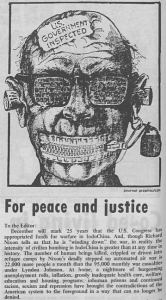
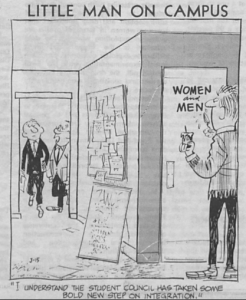
From left to right, these snippets come from [1] Oct. 25, 1971 (Vol. 7, Issue 7), [2] Oct. 25, 1971 (Vol. 7, Issue 7), [3] March 25, 1970 (Vol. 5, Issue 21)
But that doesn’t mean the paper lacks humorous or everyday content, like cartoons about student life and ads for Wrangler jeans:
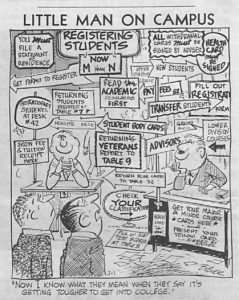
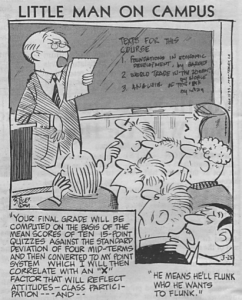
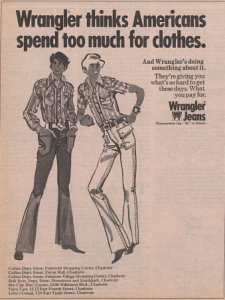
From left to right, these snippets come from [1] Sept. 17, 1969 (Vol. 5, Issue 1), [2] Sept. 24, 1969 (Vol. 5, Issue 2), [3] March 6, 1972 (Vol. 7, Issue 19)
It’s clear that these newspapers offer a fascinating perspective of what it was like to attend the University of Charlotte in the late ’60s and early ’70s. Please feel free to check out the full collection of the UNC Charlotte student newspaper here at DigitalNC!
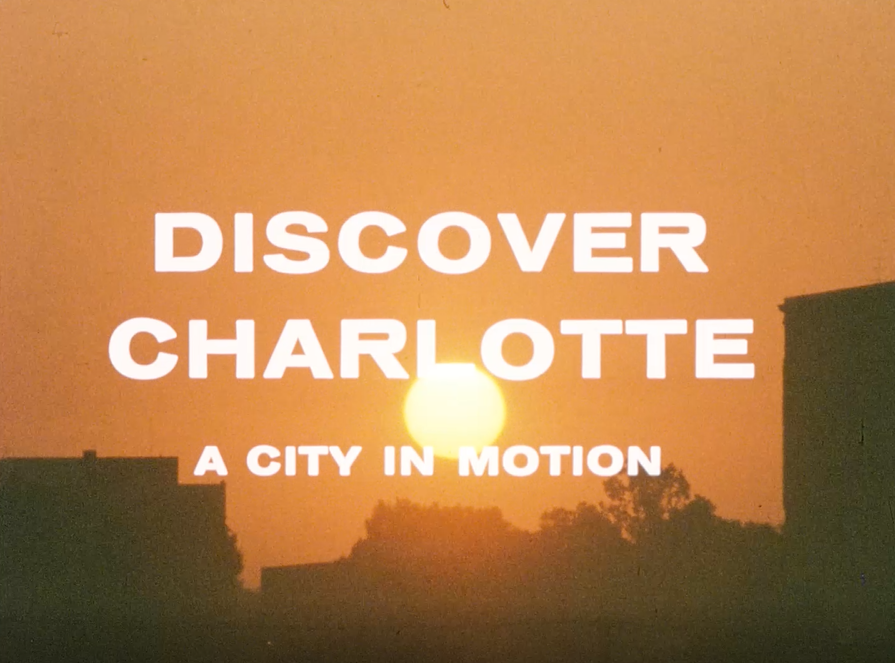
In partnership with the Charlotte Mecklenburg Library we’re pleased to share this 1968 film entitled Discover Charlotte – A City in Motion. Created by the Charlotte Chamber of Commerce and narrated by famous journalist and North Carolinian Charles Kurault, this promotional film boasts about Charlotte’s industrial and economic growth.
 In color with an upbeat soundtrack, Discover Charlotte lauds the motion of Charlotteans, beginning with a look at the city’s role in trucking, rail, and air transport. Turning to the banking industry, the film shows people processing large amounts of checks and cash and using adding machines at lightning speed. Shots of the Charlotte Record newspaper offices include coverage of Record employees learning via Teletype that Gene Payne, the Record’s cartoonist, had won a Pulitzer. You’ll see pilots and passengers at the Charlotte Douglas airport, Arthur “Guitar Boogie” and the Crackerjacks playing at the WBT station, computers whirring in a new data processing center, workers constructing a Duke power complex, and researchers examining newly woven textiles.
In color with an upbeat soundtrack, Discover Charlotte lauds the motion of Charlotteans, beginning with a look at the city’s role in trucking, rail, and air transport. Turning to the banking industry, the film shows people processing large amounts of checks and cash and using adding machines at lightning speed. Shots of the Charlotte Record newspaper offices include coverage of Record employees learning via Teletype that Gene Payne, the Record’s cartoonist, had won a Pulitzer. You’ll see pilots and passengers at the Charlotte Douglas airport, Arthur “Guitar Boogie” and the Crackerjacks playing at the WBT station, computers whirring in a new data processing center, workers constructing a Duke power complex, and researchers examining newly woven textiles.
Most of the film features scenes of middle and upper class white Charlotteans in work, social, or religious settings. In Charlotte, there is “a church for every man” and there are brief views of a number of religious institutions including Covenant Presbyterian Church, Dilworth Methodist Church, Holy Trinity Greek Orthodox Cathedral. Other events and activities shown in the film include
- Festival in the Park at Freedom Park,
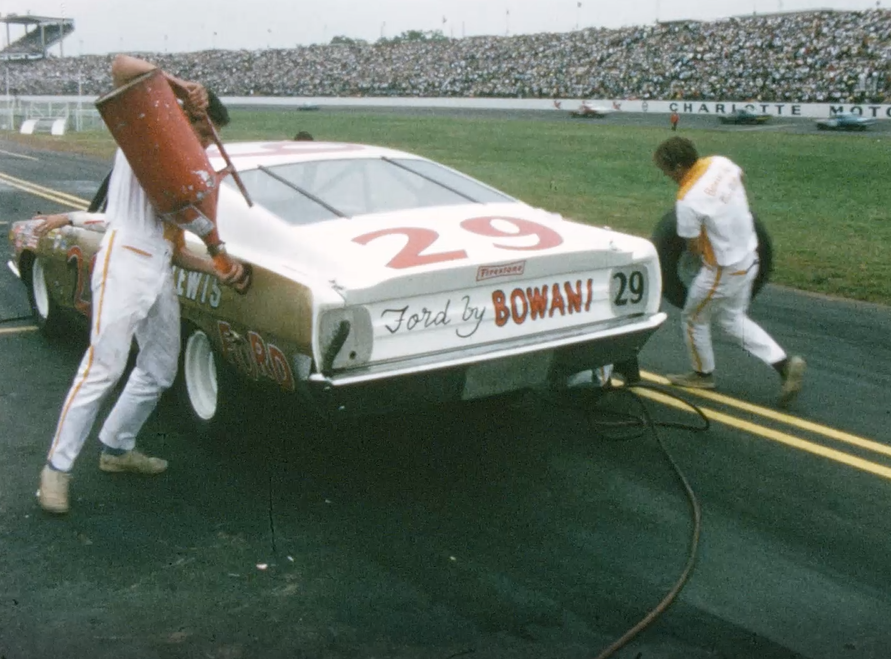
- the Mint Museum Drama Guild rehearsing a play,
- a wedding reception for an unnamed white couple,
- a Carolina v. NC State basketball game,
- a Charlotte Checkers hockey game, and
- a NASCAR stock car race.
There are also views of two university campuses, Johnson C. Smith and the relatively new UNC-Charlotte.
Filmed during the Civil Rights movement, there are only brief allusions to racial tensions. There is a snippet of white police officers talking about “riding with Negro officers,” which cuts to a group of black men and officers talking about a local march. The end of the film describes Charlotte’s participation in the Model Cities initiative and its “total attack on poverty,” efforts that were meant to eradicate urban blight that, as in many cities in America, ended up displacing and/or destroying minority-owned homes and businesses. The film ends with drawings of a planned expressway, widened streets, parks, new hotels and high rises.
This is one of a number of items Charlotte Mecklenburg Library has shared on DigitalNC. You can see more on their contributor page or learn more about their North Carolina collections on their website.
Even more issues of The Charlotte Post are available on DigitalNC now, these ones dating from 1996 and 1997. They add to an already sizable collection extending from 1930 to 1996. These 25 latest issues continue the themes of the previous decades, sharing news from the African American communities in and around Charlotte, North Carolina.
This latest batch of The Charlotte Post continues with great coverage of local, national, and even international news. Issues share news about businesses, celebrities, politics, sports, cars, entertainment, and many more.
These issues are available thanks to our partners at Johnson C. Smith University. You can view these and other issues of The Charlotte Post here. To learn more about Johnson C. Smith University, click here, or visit their partner page here.
Over 100 issues of The Carolina Journal, the student newspaper published by the University of North Carolina at Charlotte, are now available on DigitalNC, thanks to our partnership with the University of North Carolina at Charlotte. Spanning from 1965 to 1969, the student paper covers activities on and off campus.
The first issue of The Carolina Journal was published on September 7, 1965, just nine months after the college merged into the Consolidated University of North Carolina. The paper marked that transition period by documenting many of the changes on campus, including announcing new faculty members, the addition of intramural sports, and changes to rules and regulations. Early issues pay particular attention to the possibility of adding an honor code on campus.
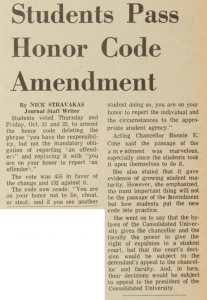
“Students Pass Honor Code Amendment,” November 3, 1965
The paper grew as the semesters changed, and was eventually regularly published weekly, documenting significant events on and off campus. For example, in December 1966, the school voted to change the mascot, and several of the following issues discussed the possible outcome of that decision. Over the next several months, several bodies on campus narrowed the list of options to three: the Forty-Niners, the Chargers, or the Cougars. Hurdles for this process included a fraudulent voter (detailed in the March 8, 1967 issue) and very strong opinions about the options. The tumult was eventually resolved and the mascot stayed the same
.
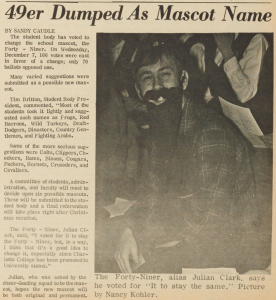
“49er Dumped As Mascot Name,” December 14, 1966
When national figures visited campus, they were featured in the paper. Stokely Carmichael visited in December 1968, and The Carolina Journal included a section in its newspaper with various photos from the event. According to the issue, the event hosted hundreds of students, and “Carmichael was greeted by raised clinched fists from the black contingent, moderate applause from the white audience, and several scattered boo’s.”
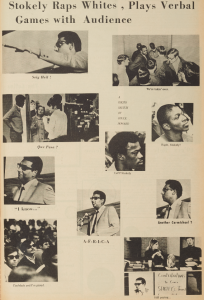
“Stokely Raps Whites, Plays Verbal Games with Audience,” December 18, 1968
To see more from the University of North Carolina at Charlotte, visit their partner page here or their website for more information.
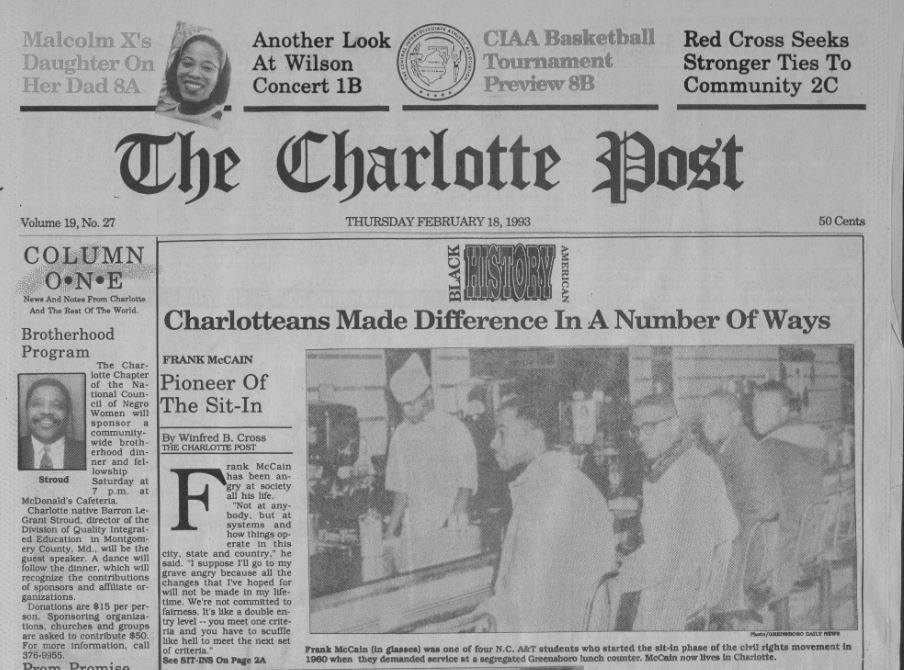
Front page of the February 18, 1993 issue of the Charlotte Post, with a focus on Black History Month
Issues of the Charlotte Post, an African American newspaper out of Charlotte, are now online, thanks to partner Johnson C. Smith University. The Charlotte Post was founded in 1878 and is a weekly publication. It still is published today, with the tagline, “The Voice of the Black Community.”
The first issues that we are making available online on DigitalNC cover 1988-1990, 1993, and 1996. Issues affecting the Black community in Charlotte, North Carolina, and the wider nation are all discussed in the 30 plus pages of each issue of the paper, from politics, including the runs of several Black politicians in local and state government, as well as Jesse Jackson’s run for president in 1988, issues with the Charlotte Mecklenburg school district, especially for Black students, and a multitude of other topics, many of which will seem not so different from the topics of today.
To view more materials from Johnson C. Smith University, go here. To view more of our newspapers, visit here.
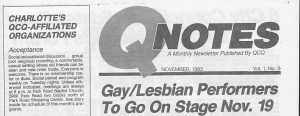
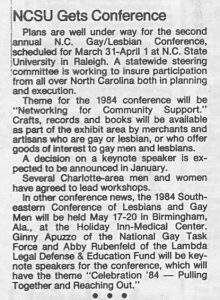 The newest batch of Q-notes, Charlotte’s LGBT newspaper, adds very early issues of Q-notes to DigitalNC. These issues from 1983 and 1984 were published as a monthly newsletter by Queen City Quordinators (QCQ), a non-profit group established in 1981 by gay activist Don King and lesbian activist Billie Stickell. According the the Q-Notes website,
The newest batch of Q-notes, Charlotte’s LGBT newspaper, adds very early issues of Q-notes to DigitalNC. These issues from 1983 and 1984 were published as a monthly newsletter by Queen City Quordinators (QCQ), a non-profit group established in 1981 by gay activist Don King and lesbian activist Billie Stickell. According the the Q-Notes website,
“The newsletter ended its run in 1984, with the close of the non-profit. In 1986, the newsletter was revived, and the publication was reborn as a monthly, print newspaper. The first issue of the revived community news source was published in June 1986, to coincide with National LGBT Pride Month.”
The early Q-Notes QCQ newsletters shed light on issues facing the LGBT community in Charlotte in the early 1980s and show the some of the grassroots resources and organizations pushing for information, safety, and acceptance. Conferences, meetings, and support groups were highlighted as ways of finding and building communities. Another important resource was the Gay/Lesbian Switchboard, a volunteer-run hotline providing information to Charlotte’s LGBT community.
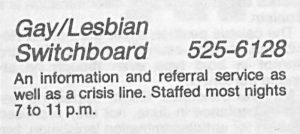
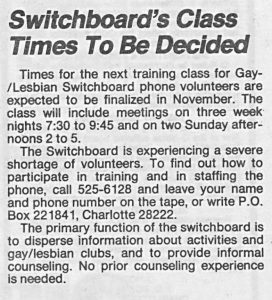 This batch also includes newer issues of Q-notes from the 2000s, completing our run of Q-notes provided by our partner, University of North Carolina at Charlotte. To see more materials from University of North Carolina at Charlotte visit their DigitalNC partner page or take a look at their website.
This batch also includes newer issues of Q-notes from the 2000s, completing our run of Q-notes provided by our partner, University of North Carolina at Charlotte. To see more materials from University of North Carolina at Charlotte visit their DigitalNC partner page or take a look at their website.
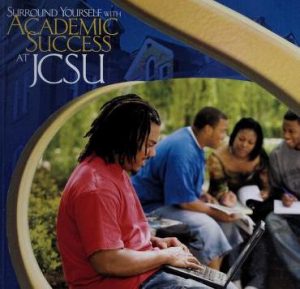
Image from the cover of the 2006-2007 JCSU catalog.
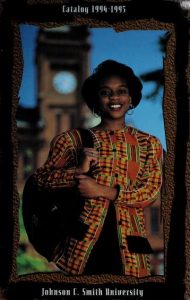
Cover of the 1994-1995 JCSU catalog.
A new batch of catalogs from Johnson C. Smith University is now available on DigitalNC. Johnson C. Smith University is a historically Black four-year research university located in Charlotte, North Carolina. It was established in 1867 as Biddle Memorial Institute but changed its name to Biddle University in 1876, and to Johnson C. Smith University in 1923. Currently JCSU serves over 1,600 students and offers 24 different undergraduate degree programs and a graduate Master of Social Work degree program.
Catalogs in this batch cover two spans of time. The first run of catalogs covers 1878-1909 when the school was Biddle University. The more recent run covers JCSU from 1964-2009. School catalogs include course offerings as well as information such as academic schedules, school history, and more. These newly digitized catalogs join previously digitized JCSU catalogs and bulletins from the 1920s-1960s.
In addition to these catalogs, make sure to take a look at other materials from JCSU including yearbooks and maps. To learn more about Johnson C. Smith University, visit their DigitalNC partner page or their website.
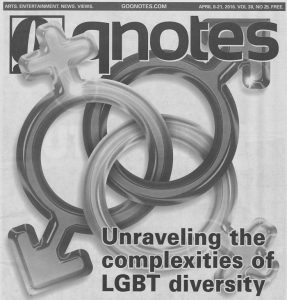
The cover of the April 8-21 issue of Q-notes
The last batch of Q-notes, a newspaper provided by our partner, the University of North Carolina at Charlotte, covers the years 2005-2010 and 2015-2016. These issues join previously digitized issues from 1986-2004 on DigitalNC, and digitized issues on the Q-notes website from 2008-2013.
Q-notes is newspaper that serves the LGBT community in North Carolina with a focus on Charlotte and the surrounding areas. The currently digitized span shows the evolution of relevant LGBT issues in the American South from the late 1980’s through the late 2010’s, which mirrors the evolution of the look and feel of Q-notes as a publication.
In the last two decades, incremental strides have been taken in terms of legal equality and acceptance of the LGBT community, much of which has been documented in the pages of Q-notes. Q-notes has captured issues such as the struggle for the legal status of same-sex marriage to the Don’t Ask Don’t Tell Repeal Act to an increase in representation of LGBT individuals in the media culture. More current issues of Q-notes remind us that we have a ways to go, for example providing legal protection for and cultural inclusion of trans and non-binary individuals.
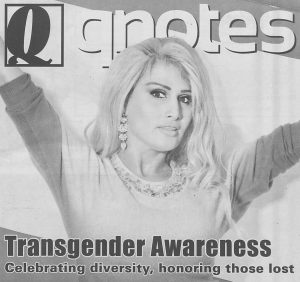
The cover of the November 4-17 issue of Q-notes
During the past 20 years, Q-notes has also evolved from an 8 page monthly paper with an underground aesthetic to a much longer bi-weekly publication with a more polished appearance that is matched by a constantly updated website.
To learn more about Q-Notes, visit their website. To learn more about our partner, University of North Carolina at Charlotte, visit their partner page or take a look at their website.
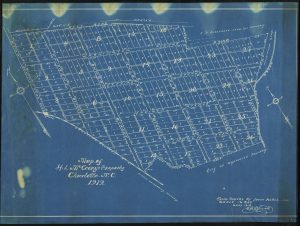
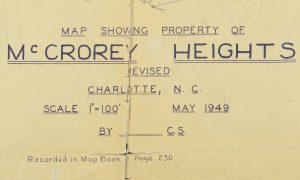
The heading of a 1949 property map of McCrorey Heights
A set of maps contributed by our partner, Johnson C. Smith University, show property divisions over time in the McCrorey Heights area of Charlotte, North Carolina. McCrorey Heights is a neighborhood in west Charlotte that was established by Johnson C. Smith University President H. L. McCrorey at the turn of the century. In the early 1900s, the neighborhood was a home to the city’s Black professional class and continues to be heavily associated with Johnson C. Smith University.
The six maps show the area from 1912-1949, and changes in the neighborhood property lines can be tracked over this time period. The 1949 maps include names of community member associated with each section of property along with other hand-written notations. These maps help tell the story of Charlotte’s history.
To see more materials from Johnson C. Smith University, take a look at their DigitalNC partner page or visit their website to learn more.
A new batch of materials from our partner, The Grand Lodge of Ancient, Free and Accepted Masons of North Carolina are now up on DigitalNC. This set includes minute books, scrapbooks, historical manuscripts, letters and charters, some dating back to the 18th century. Several physical artifacts have been digitized, including a commemorative apron and a souvenir pin from the turn of the 20th century.
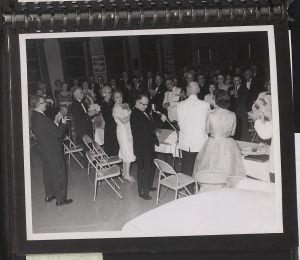
A celebration for the installation of James Brewer as Grand Master in 1961.
The minute books are from all around the state, including Chapel Hill, Charlotte, Statesville and Boone. Also included is a letter from Edward K. Graham, President of UNC, to Grand Master Andrews inviting him to the 1916 University Day ceremony. There are also several scrapbooks included, with photographs including receptions and various programs, including the 275th Anniversary of the United Grand Lodge of England in West London in June 1992.
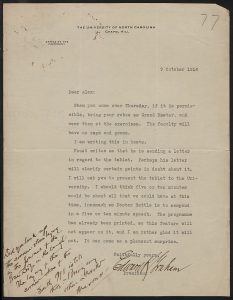
UNC President Edward K. Graham inviting Grand Master Andrews to wear his Masonic regalia to the 1916 University Day ceremony
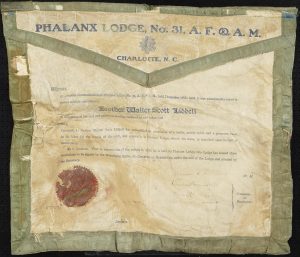
Commemorative apron honoring the services of Walter Scott Liddell
To see more materials from The Grand Lodge of Ancient, Free and Accepted Masons of North Carolina, visit their partner page or take a look at their website or our previous blog posts.















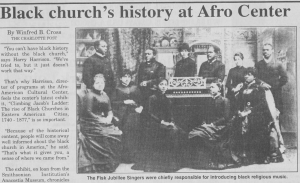
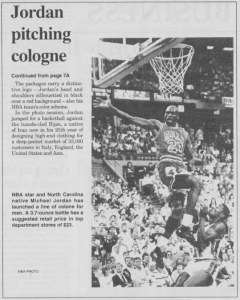
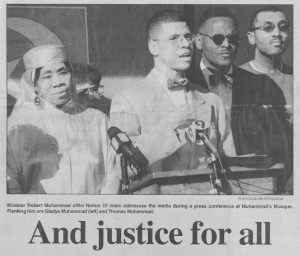





 The newest batch of
The newest batch of 










